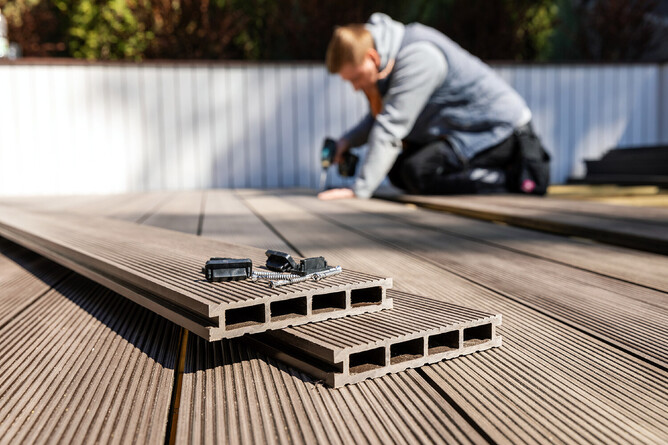Wood
Wood is a renewable resource that sequesters (removes) carbon dioxide from the atmosphere as the tree grows and locks it away until the wood decays or is burned. Wood can last many years but it does weather and requires periodic application of stains and sealers.
When a wood deck is demolished and removed the material can be reused, burned as firewood (unless it is pressure treated wood!), and composted in municipal composting facilities that chip it and turn it into soil.
Composite
Composite decking can range from fiberglass to plastic while most are a mixture of plastic and wood fibers. Composite decking manufacturers claim long-term cost as the main advantage to using their product. Decking is available in many textures and colors and never needs to be stained or sealed. Composite decking is resistant to rotting and insects, and it even meets the strict fire codes in California.
The Problem with Composite Decking
What makes it so environmentally friendly on the material-sourcing and manufacturing end also makes composite decking unsustainable on the installation and end-of-life side. When you mix an industrial material (plastic) that is recyclable with a biological materials (wood) that is compostable you get a material that is neither recyclable nor compostable. This is what William McDonough and Michael Braungart call a"monstrous hybrid" in their groundbreaking book "Cradle to Cradle: Remaking The Way we Make Things."
As a result, any sawdust or construction scrap is destined for the landfill. Since perfect collection of sawdust is nearly impossible a miter saw will spread plastic/wood sawdust throughout the construction site. If your deck uses 100 twelve-foot boards and you are averaging three cuts per board with a 1/8-inch saw blade you will produce 8 pounds of this monstrous hybrid, a significant portion of which may blow away in the wind. I also estimate at least 100 pounds of scrap that will go to the landfill, even after you make as many composite birdhouses as you can.
Mediocre Hardness
Purple heart decking is almost 10 times harder than composite products. While this medium hardness may be fine for your backyard where a couple people walk across it daily, imagine the damage wrought by hundreds of thousands of people walking across a boardwalk each day. As we will see in the points below, damaging the outer core of composite decking can be catastrophic, and this lower hardness practically ensures that damage will occur in such high traffic conditions.
Slippery
What is plastic? It is an oil based product. Oil and water do not mix, and when this is attempted, you get a very slippery surface. Most composite manufacturers have attempted to fix this by adding texture and faux wood grain, and in many cases, they have had some success. But look at your average deck. As stated above, the heat build up will degrade the plastic and even cause it to weep oil.
Heat Build up
Composite Decking is essentially plastic. Some manufacturers use an outer shell of pure polyethylene (the same stuff used in water bottles), while others blend the plastic in with the wood flour (ground up wood product). Plastic is notorious for retaining heat and getting very hot in direct sunlight. Again, while this may be fine in your shaded or partially shaded backyard, a seaside decking is in direct sunlight all day long. I wouldn’t recommend walking barefoot on any boardwalk for many reasons, but it happens. At least once anyway. Once you burn your feet, you probably won’t do it again. In addition to the discomfort factor, when plastic heats up, it breaks down. Some variants will exude their oils, some will let off gas byproducts, but all of them will weaken over time. Suddenly your boardwalk is very hot, and it smells like… well, burned plastic. Plastic also retains its heat longer, and even after the sun goes down, the boardwalk will still be hot, and that plastic will continue to break down. This constant bombardment day in and day out will result in a boardwalk that needs to be replaced rather quickly.
Not Weather and Mold Resistant
This may be the most shocking element of composite decking that people don’t usually realize. The original composites were homogenous mixes of wood flour and polyethylene or PVC extruded into boards. These quickly fell out of favor (mostly due to class action lawsuits), because wood flour is still wood, and it will absorb moisture very quickly despite the plastic binders. Real wood contains complex structures that absorb and shed water and nutrients that feed the tree. Natural resins protect against insects and mold. Wood flour is basically wood ground very fine, thus eliminating all the natural resins and cellular structure that defeats insects and mold. The cellulose that is left over in wood flour is like candy to mold, since it is already broken down into simple sugar form. Later “advancements” encased this wood flour core with pure plastic “cap stock,” thus blocking out all these harmful factors from the vulnerable inner core. This, however, produces a bigger issue now that there is a heterogeneous construction that reacts differently to heating and cooling and daily wear and tear. This process can crack the shell or cause it to separate from the core,thus compromising the strength and weather resistance. If the thin cap stock is punctured, the inner core is exposed to the elements where mold and decay can take hold. Just the act of installing the decking will puncture this, as the boards are screwed down or cut to length exposing the core.
Strength
The strength of the composite materials will vary from manufacture to manufacture, but the fine print of most installation manuals will recommend you install the decking boards on 12″ on center joists. The typical 16″ center can be done, but bounce and deformation is more likely. Most plastic has a “memory” too, and once it is deformed, it won’t spring back. The wood flour core is not very strong and relies upon the outer plastic shell to stiffen it. If this shell is compromised in any way, the strength will fall off considerably. Now, release the summertime throng of traffic on the boardwalk and imagine how that bounce and deformation quotient will climb exponentially.
The Bottom Line On Decking
What it all comes down to is personal preference and values. The environmental impact of composite decking can be minimized by planning all cuts to minimize scrap and by carefully capturing the sawdust. On the other hand, a wood deck is made from a natural and renewable material that won't end up in the landfill.
Sources:
Tree Hugger
Mcilvain



